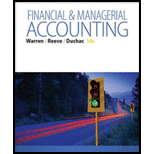
Financial & Managerial Accounting
13th Edition
ISBN: 9781285866307
Author: Carl Warren, James M. Reeve, Jonathan Duchac
Publisher: Cengage Learning
expand_more
expand_more
format_list_bulleted
Concept explainers
Question
Chapter 6, Problem 6.6APR
To determine
Lower-of-cost-or-market value:
The lower-of-cost-or-market value is a method which requires the reporting of the ending merchandise inventory in the financial statement of a company, at its current market value (net realizable value) or at its historical cost price, whichever is less.
value of inventory using first in first out method under lower-of-cost-or-market inventory.
Expert Solution & Answer
Want to see the full answer?
Check out a sample textbook solution
Students have asked these similar questions
I need the correct answer to this general accounting problem using the standard accounting approach.
Provide answer
Step by step answer
Chapter 6 Solutions
Financial & Managerial Accounting
Ch. 6 - Before inventory purchases are recorded, the...Ch. 6 - Why is it important to periodically take a...Ch. 6 - Do the terms FIFO, LIFO, and weighted average...Ch. 6 - If inventory is being valued at cost and the price...Ch. 6 - Which of the three methods of inventory...Ch. 6 - If inventory is being valued at cost and the price...Ch. 6 - Using the following data, how should the inventory...Ch. 6 - Prob. 8DQCh. 6 - Hutch Co. sold merchandise to Bibbins Company on...Ch. 6 - A manufacturer shipped merchandise to a retailer...
Ch. 6 - Prob. 6.1APECh. 6 - Prob. 6.1BPECh. 6 - Perpetual inventory using FIFO Beginning...Ch. 6 - Perpetual inventory using FIFO Beginning...Ch. 6 - Perpetual inventory using UFO Beginning inventory,...Ch. 6 - Perpetual inventory using LIFO Beginning...Ch. 6 - Perpetual inventory using weighted average...Ch. 6 - Perpetual inventory using weighted average...Ch. 6 - Periodic inventory using FIFO, LIFO, and weighted...Ch. 6 - Periodic inventory using FIFO, UFO, and weighted...Ch. 6 - Prob. 6.6APECh. 6 - Lower-of-cost-or-market method On the basis of the...Ch. 6 - Prob. 6.7APECh. 6 - Prob. 6.7BPECh. 6 - Inventory turnover and number of days' sales in...Ch. 6 - Inventory turnover and number of days' sales in...Ch. 6 - Control of inventories Triple Creek Hardware Store...Ch. 6 - Prob. 6.2EXCh. 6 - Perpetual inventory using FIFO Beginning...Ch. 6 - Perpetual inventory using LIFO Assume that the...Ch. 6 - Perpetual inventory using LIFO Beginning...Ch. 6 - Perpetual inventory using FIFO Assume that the...Ch. 6 - FIFO and LIFO costs under perpetual Inventory...Ch. 6 - Prob. 6.8EXCh. 6 - Prob. 6.9EXCh. 6 - Prob. 6.10EXCh. 6 - Prob. 6.11EXCh. 6 - Prob. 6.12EXCh. 6 - Periodic inventory by three methods; cost of...Ch. 6 - Comparing inventory methods Assume that a firm...Ch. 6 - Lower of cost or market inventory On the basis of...Ch. 6 - Merchandise inventory on the balance sheet Based...Ch. 6 - Effect of errors in physical inventory Missouri...Ch. 6 - Effect of errors in physical inventory Fonda...Ch. 6 - Prob. 6.19EXCh. 6 - Prob. 6.20EXCh. 6 - Prob. 6.21EXCh. 6 - Prob. 6.22EXCh. 6 - Retail method A business using the retail method...Ch. 6 - Retail method A business using the retail method...Ch. 6 - Retail method On the basis of the following data,...Ch. 6 - Gross profit method The inventory was destroyed by...Ch. 6 - Prob. 6.27EXCh. 6 - Gross profit method Based on the following data,...Ch. 6 - FIFO perpetual inventory The beginning inventory...Ch. 6 - Prob. 6.2APRCh. 6 - Prob. 6.3APRCh. 6 - Prob. 6.4APRCh. 6 - Prob. 6.5APRCh. 6 - Prob. 6.6APRCh. 6 - Prob. 6.7APRCh. 6 - FIFO perpetual inventory The beginning inventory...Ch. 6 - Prob. 6.2BPRCh. 6 - Weighted average cost method with perpetual...Ch. 6 - Prob. 6.4BPRCh. 6 - Prob. 6.5BPRCh. 6 - Prob. 6.6BPRCh. 6 - Retail method; gross project method Selected data...Ch. 6 - Prob. 6.1CPCh. 6 - Prob. 6.2CPCh. 6 - Costing inventory Golden Eagle Company begun...Ch. 6 - Inventory ratios for Dell and HP Dell Inc. and...Ch. 6 - Prob. 6.5CPCh. 6 - Prob. 6.6CP
Knowledge Booster
Learn more about
Need a deep-dive on the concept behind this application? Look no further. Learn more about this topic, accounting and related others by exploring similar questions and additional content below.Similar questions
- Timberline worked on four jobs during its first yeararrow_forwardWhat is the correct answer with accounting questionarrow_forwardKimberly, Inc. has accounts receivable of $28,500, total assets of $342,000, cost of goods sold of $195,200, and a capital intensity ratio of 1.14. What is the accounts receivable turnover rate?arrow_forward
arrow_back_ios
SEE MORE QUESTIONS
arrow_forward_ios
Recommended textbooks for you
 Survey of Accounting (Accounting I)AccountingISBN:9781305961883Author:Carl WarrenPublisher:Cengage Learning
Survey of Accounting (Accounting I)AccountingISBN:9781305961883Author:Carl WarrenPublisher:Cengage Learning Financial Accounting: The Impact on Decision Make...AccountingISBN:9781305654174Author:Gary A. Porter, Curtis L. NortonPublisher:Cengage Learning
Financial Accounting: The Impact on Decision Make...AccountingISBN:9781305654174Author:Gary A. Porter, Curtis L. NortonPublisher:Cengage Learning- Principles of Accounting Volume 1AccountingISBN:9781947172685Author:OpenStaxPublisher:OpenStax College
 Financial And Managerial AccountingAccountingISBN:9781337902663Author:WARREN, Carl S.Publisher:Cengage Learning,
Financial And Managerial AccountingAccountingISBN:9781337902663Author:WARREN, Carl S.Publisher:Cengage Learning, Financial AccountingAccountingISBN:9781337272124Author:Carl Warren, James M. Reeve, Jonathan DuchacPublisher:Cengage Learning
Financial AccountingAccountingISBN:9781337272124Author:Carl Warren, James M. Reeve, Jonathan DuchacPublisher:Cengage Learning


Survey of Accounting (Accounting I)
Accounting
ISBN:9781305961883
Author:Carl Warren
Publisher:Cengage Learning

Financial Accounting: The Impact on Decision Make...
Accounting
ISBN:9781305654174
Author:Gary A. Porter, Curtis L. Norton
Publisher:Cengage Learning

Principles of Accounting Volume 1
Accounting
ISBN:9781947172685
Author:OpenStax
Publisher:OpenStax College

Financial And Managerial Accounting
Accounting
ISBN:9781337902663
Author:WARREN, Carl S.
Publisher:Cengage Learning,

Financial Accounting
Accounting
ISBN:9781337272124
Author:Carl Warren, James M. Reeve, Jonathan Duchac
Publisher:Cengage Learning
Chapter 6 Merchandise Inventory; Author: Vicki Stewart;https://www.youtube.com/watch?v=DnrcQLD2yKU;License: Standard YouTube License, CC-BY
Accounting for Merchandising Operations Recording Purchases of Merchandise; Author: Socrat Ghadban;https://www.youtube.com/watch?v=iQp5UoYpG20;License: Standard Youtube License